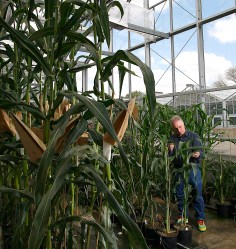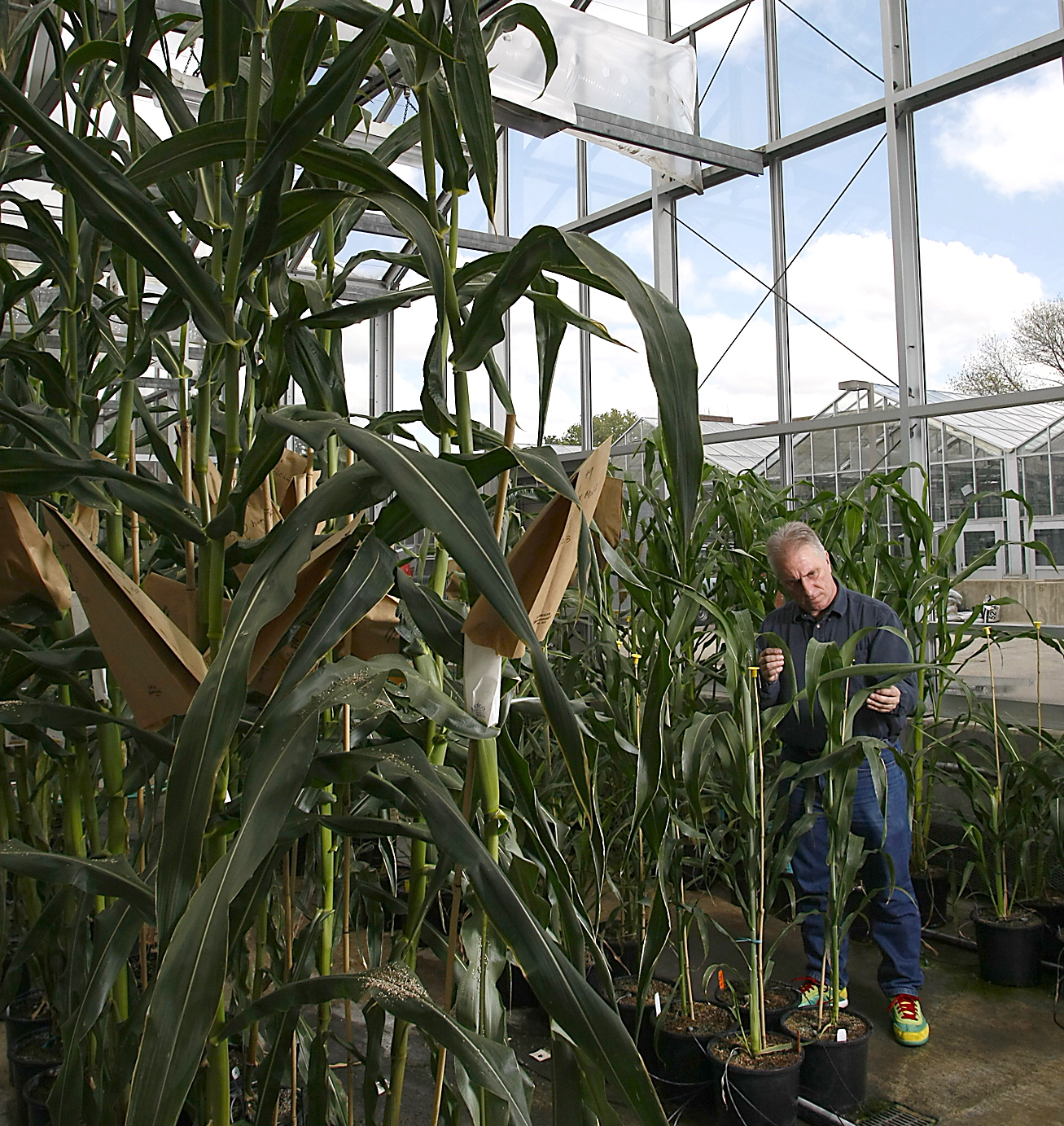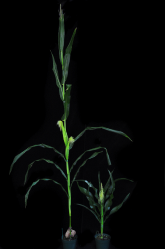
“Honey, I shrunk the corn.” Scientist Burkhard Schultz examines his miniature corn stalks in the lab. (Photos c/o Purdue University.)
If modern baseball can teach kids anything about science, it’s that steroids make things huge. We’ve all seen players with tree-trunk sized arms blast baseballs out of ballparks thanks to steroid hormones that bulk up muscle cells.
But what’s good for athletic prowess isn’t always good for farmers. Take corn — a crop we grow on 70 million acres of the nation’s farmland. Naturally occurring veggie steroids give corn long stalks, which require lots of water and fertilizer to grow.
When Purdue University researchers set out to miniaturize corn in an effort to help conserve water and fertilizers and reduce pesticide use, they searched for ways to do the opposite of what BALCO did for Barry Bonds. “If you take away the steroid from a plant,” said lead researcher Burkhard Schulz, a self-described plant architect, “you receive a very small plant.”
Similar results are possible with wheat, barley, rice, and other cereal crops, according to Schulz. And work is already underway to produce smaller sorghum.
To unlock the key to reliably growing dwarf corn, Schulz’s team exposed crops to regular doses of fungicide.
Fungus is a common affliction of grasses and agricultural crops, and a number of chemicals have been developed to kill it. (You could even call fungus a cereal killer.) Corny jokes aside, the particular fungicide Schultz used interferes with the enzymes needed to produce growth-inducing steroids. It can have a similar effect on plants, making it popular with ornamental plant growers.
After figuring out which enzymes to switch off, Schulz turned to plant breeding to develop the dwarf corn. He said selective breeding was chosen for the project over genetic engineering because it’s cheaper and easier.
The Purdue scientists studied the genes of corn kernels kept at the Maize Genetics Co-op in Champaign, Ill. They picked out seeds harvested from abnormally small plants, pinpointed genetic defects that would have the desired effect on the plants’ growth enzymes, and then bred and grew plants that harbored those defects.
“We found that in some species we can create plants that are significantly smaller, but make about the same amount of seed,” Schulz said. “Which means that you need to put in less water and less nutrients to get the same output.”
The lack of plant steroids has another upside — they feminized the plants. That allowed them to grow corn ears, which are the plant’s female sex organs, without wasting energy on pollen, or corn sperm.
So far the stunted corn plants have only matured in research greenhouses, with some strains growing to less than a quarter of their normal height while still producing more than half the typical weight in corn kernels.
But the selectively bred corn was recently planted in two acres of research farmland in West Lafayette, Ind. Following rain, the seedlings are beginning to push through the ground. Within two months, Schulz will know whether his team was successful in cultivating a bonsai cornfield that demands less water and fertilizer while still offering up bountiful yields.
The research has been underway for three years and Schulz said it could be another five years before the crops are grown commercially. If and when that happens, it might make for less amazing maize mazes, but the benefits of going dwarf could be huge, from a resource perspective. “This is important if you think about future climate developments, if you have the ability to deliver less water,” Schulz said. “You might be able to grow plants in areas where you weren’t able to before because the conditions and climate didn’t allow it.”
The experimental crops being grown in the field by Schulz do not need to use the fungicide. Regardless, Schulz has been fielding calls from growers and ag companies seeking advice for using the fungicide to manipulate the size of their plants, since he co-published a paper describing some of the research results in the online journal PLoS ONE in May.
A rose grower who contacted Schulz even plans to use the fungicide to shorten his flowers’ stems.
The agricultural and golf course industries describe propiconazole, the cheap and widely used fungicide Schultz used in the early stages of the research, as safe. It’s used on turf and crops to kill fungal pathogens.
But it also harms reproductive health in animals, including humans, leading the World Health Organization to characterize it as “moderately hazardous,” while the U.S. Environmental Protection Agency calls it “moderately toxic.” Pesticide safety advocates also say the product’s widespread use is helping pathogens develop resistance to antifungal medicine.
“It’s really bad news; it shouldn’t be used,” said Margaret Reeves, an agricultural ecologist at the Pesticide Action Network of North America. “We know that there are some really serious health effects.”
Of course, further genetic studies and selective breeding could help scale back the size of a wide variety of crops without the need for toxic chemicals. But that will only matter if ag companies are willing to bite.
Related video: Purdue University’s Shulz talks about his work with miniature corn plants.




